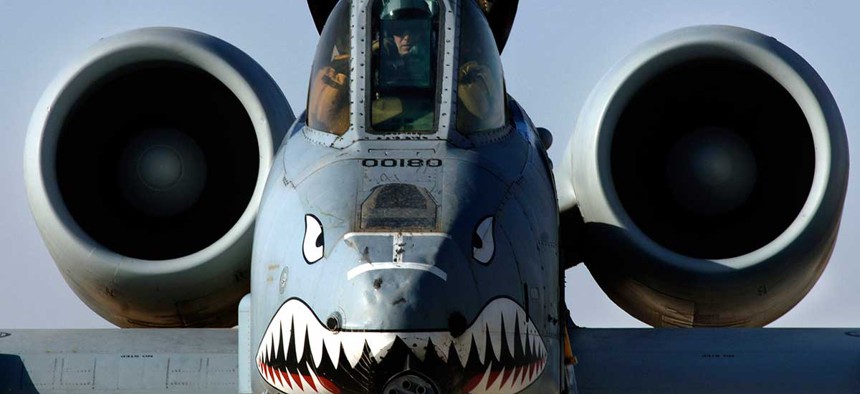Air Force to Delay A-10 Retirement
After trying to retire the battle-tested Warthog for the past two years, Air Force officials concede that the plane is key to the war on ISIS.
The Air Force is shelving its immediate plans to retire the A-10 Warthog attack plane, which has become critical to the U.S. bombing campaign against Islamic State militants in Iraq and Syria, Pentagon officials tell Defense One.
Air Force officials say they still need to retire the A-10 to make room for newer warplanes, but that the calculus for its sunsetting has been thrown off by commanders’ demands for the Warthog now.
Putting the A-10’s retirement plans on hold is a key policy shift that will be laid out next month when the Pentagon submits its 2017 budget request to Congress, said Pentagon officials who spoke on the condition of anonymity because they were not authorized to discuss the Obama Administration's spending plan before its official release.
An Air Force spokeswoman declined further comment because the Pentagon’s budget request has not been finalized and publicly released.
Top Air Force officials had already hinted that the A-10 retirement plans might be put on hold due to the planes’ demand in combat.
“I think moving it to the right and starting it a bit later and maybe keeping the airplane around a little bit longer is something that’s being considered based on things as they are today and that we see them in the future,” Gen. Herbert “Hawk” Carlisle, the head of Air Combat Command, said in November.
The A-10, known for its ability to withstand enemy ground fire, proved even more difficult to shoot down politically; Congress blocked its retirement for the past two years.
The venerable attack plane, often championed by Army and Marine Corps ground forces, was built to fly low and slow, close to the battlefield to work in tandem with ground troops. Top Air Force officials acknowledged that the A-10 flies these so-called close air support missions better than any other plane in the arsenal. But officials said other aircraft, could fly these missions, albeit not as well as the Warthog, and retirement would free up money to pay for newer planes, like the F-35 Joint Strike Fighter, a more expensive warplane intended to replace the A-10 and F-16 fighter.
Two years ago when the Air Force first proposed sending the A-10s into retirement, the service planned to shift maintenance workers from the Warthog to the new F-35 Joint Strike Fighter. At the time, no American forces were in Iraq or Syria and Washington was preparing to withdraw troops from Afghanistan. But since then, ISIS has spread across the Middle East and a resurgence of the Taliban has delayed the drawdown in Afghanistan.
The Air Force’s request to retire the A-10 has met with a wide wave of negative responses. In the midst of it all, the Air Force has deployed squadrons to fly combat missions against ISIS in both Iraq and Syria. Warthogs have also deployed to Europe where they flew in military drills with NATO allies.
Opponents of the A-10 retirement say the plane is effective both in lethality and cost for the current wars when compared to newer, high-performance aircraft like the F-16 fighter or B-1B bomber.
Congress has routinely blasted the Air Force’s A-10 retirement plans and blocked its retirement. Sen. Kelly Ayotte, R-N.H., one of the Warthog’s biggest advocates on Capitol Hill, held up the nomination of Air Force Secretary Deborah Lee James, over the matter.
“I welcome reports that the Air Force has decided to keep the A-10 aircraft flying through fiscal year 2017, ensuring our troops have the vital close-air support they need for missions around the world,” Sen. John McCain, R-Ariz., chairman of the Senate Armed Services Committee, said in response to Defense One’s report that the plane’s retirement would be delayed.
“With growing global chaos and turmoil on the rise, we simply cannot afford to prematurely retire the best close air support weapon in our arsenal without fielding a proper replacement,” he said.
Rep. Martha McSally, R-Ariz., a former A-10 pilot who flew combat missions in the 1990s during Southern Watch, also lauded the decision to delay the A-10 retirement.
“It appears the [Obama] Administration is finally coming to its senses and recognizing the importance of A-10s to our troops’ lives and national security,” McSally said in a statement.
“With A-10s deployed in the Middle East to fight ISIS, in Europe to deter Russian aggression, and along the Korean Peninsula, administration officials can no longer deny how invaluable these planes are to our arsenal and military capabilities,” she said.
McSally said the Warthog must stick around “until we know without a doubt we can replace their capabilities.








